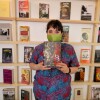How a Cafeteria Worker Uses Math to Keep Kids Fed

Counting fruits and other foods that are part of breakfast and lunch for over 500 elementary school students is one of Amalia Cano’s daily chores. Cano has been a school cafeteria employee in the Los Angeles Unified School District (LAUSD) for the past 20 years.
Cano says that encouraging the children at Betty Plasencia Elementary School to eat their fruits and vegetables daily is one of her goals.
“I like to persuade kids to eat their vegetables, fruits, and food in general, so that it doesn’t end up in the trash, which I think is a shame,” Cano says. “Plus, if they are well fed, they learn better.”

Cano, who is originally from Guatemala, says her job changed a great deal when schools closed during the pandemic, and later, when in-person classes resumed. What has not changed, she affirms, is using math concepts in her work at the cafeteria.
“We have to bag everything now: breakfast and lunch. We count the bags and boxes daily; the quantity changes frequently depending on attendance,” she explains. And it doesn’t end there.
“We also have to find out how many kids grabbed lunch and make sure it matches the numbers in the system,” and she adds, “I use math for that and to adjust how much food will be needed each day.”
As a mother, Cano also looks for creative ways to get her kids excited about math.
“I do it because math is useful for everything. Fortunately, my kid loves it. I always try to make it fun, like when we go to the river and count pebbles,” she says. Her son is 7 years old and is in the third grade. “Sometimes, we count M&M’s and make groups of the same color.”
Cano firmly believes that all children are bright and that parents can find alternative ways for them to enjoy learning math.
“We must encourage our kids to learn because their education is the most important thing if they want to get ahead in this country.”


